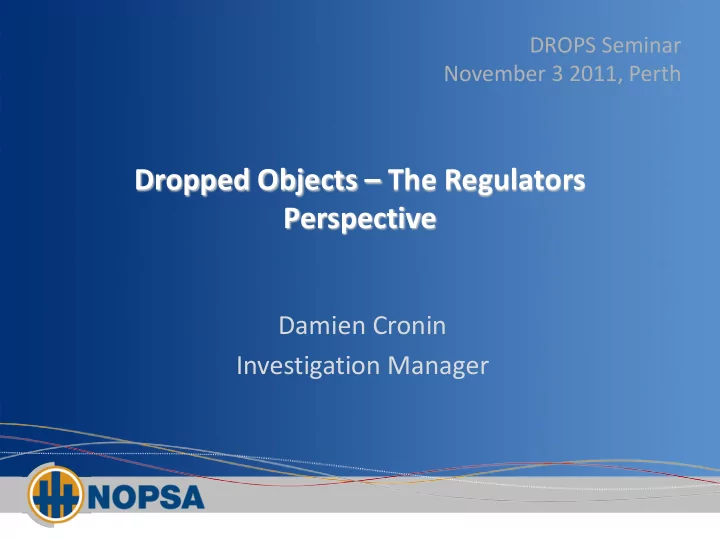

DROPS Seminar November 3 2011, Perth Dropped Objects – The Regulators Perspective Damien Cronin Investigation Manager
What I will cover • NOPSA Legislated Functions • NOPSA Operational Functions • What the Regulator does • 2010-2011 Activities • Accident & Dangerous Occurrence Analysis • What is working and areas for improvement 2
Legislation administered by NOPSA Commonwealth Offshore Petroleum and Greenhouse Gas Storage Act • Schedule 3 to Cth OPGGSA 2006 • Offshore Petroleum and [OPGGSA] Greenhouse Gas Storage (Safety) Regulations 2009 Schedule 3 – OHS law • Part 5 of the OPGGS (Resource Management and Administration) Regulations Safety Regulations 2011 [Wells regulations] Commonwealth Attorney-General’s website: comlaw.gov.au Wells regulations 3
NOPSA’s functions Promote Advise Co-operate Monitor & Report Enforce Investigate
What does the regulator do? Challenge the Operator – Thorough Safety Case assessments - targeted – Rigorous facility inspections – sampled verification scope – Comprehensive incident investigation – depending on severity – Principled Enforcement – verbal / written and prosecutions Independent assurance – Facility health and safety risks are properly controlled by Operators of facilities through securing compliance with OHS law – Titleholders of wells through wells regulation
What else does the Regulator do? • Engage with Operators at all levels from management to members of the workforce: – Guidance material, operator liaison and workshops – Industry and Operator-specific performance feedback – National Programmes and themed audit inspections – Early engagement safety case assessment for complex facilities with a focus on inherent safety in design. • Implemented by a critical mass of professional and skilled inspectors
Facilities Facility Group Based on Current (2011) data * Platforms 60 FPSOs 15 MODUs 15 Vessels 10 Pipelines 110 TOTAL: 210 * Numbers fluctuate slightly as facilities e.g. mobile facilities and inactive facilities
2010-11 Activities INDUSTRY NOPSA 33 Operators 33 OHS Inspectors 210 Facilities 20 Support staff 286 Assessments 218 Assessments 365 Incidents 152 Inspections 43 Accidents 1 Major Investigation 31 Minor Investigations 333 Incident reviews 322 Dangerous Occurrences 78 Enforcement actions 7 Safety Alerts
Dropped Objects Statistics • Reporting period from Jan 2010 – Oct 2011 – Equivalent of 21 Months • Total notifications (dropped objects) received = 44 • Gauging Potential – Death or Serious Injury = 27 (61%) – Incapacitation > 3 days = 14 (32%) – Conclusion = 41 (93%) of reported incidents had potential for harm
Dropped Objects By Facility Type • MODU = 28 (64%) • Fixed Platform = 8 (18%) • FPSO = 5 (11%) • Construction Vessel = 3 (7%) • Total = 44 (100%)
Outcomes of Incidents • Actual Harm to Personnel = 6 (14%) • Operational Delays/Stoppages = 24 (55%) • Damaged Equipment = 23 (52%) Note – Some incidents may have more than one outcome!
Closer Analysis • Root Cause Analysis 1 – Equipment Design = 17 (39%) – Problems not anticipated – Procedures = 7 (16%) – Not followed/Wrong/Inadequate/None – Management System Failings = 5 (11%) – Corrective Actions Need Improvement/MOC needs Improvement
Closer Analysis • Root Cause Analysis 2 – Work Direction = 3 (7%) – Supervision/Preparation & Planning – Training = 2 (5%) – Understanding Needs Improvement – Communications = 2 (5%) – Misunderstood/No Communication
Example 1 – Fixed Platform • Equipment – Wheeled Beam Trolley • Weight – Approx. 12kg • Height – 13 Metres to the deck • Injury – No • Potential - Death or Serious Injury • Equipment Damage – Trolley Destroyed • Production Stoppage – N/a • Root Cause Analysis – Design Specs (problem not anticipated)
Example 1 - Pictures
Example 2 - MODU • Equipment – 8” Pipe Wrench • Weight – 330g • Height – 30 metres to the drill floor • Injury - No • Potential – Death or Serious Injury • Equipment Damage – N/a • Production Stoppage – N/a • Root Cause Analysis – Preparation & Lack of Supervision during work
Example 2 - Pictures
Example 3 - FPSO • Equipment – Pneumatic ‘rattle gun’ • Weight – 1 kg • Height – 26 Metres to the bottom level of the turret space • Injury - No • Potential – Death or Serious Injury • Equipment Damage – Gun destroyed • Production Stoppage – N/a • Root Cause Analysis – Work Direction – lack or supervision
Example 3 - Pictures
Example 4 – Construction Vessel • Equipment – Wheeled Trolley Beam • Weight – 37 kg • Height – 2.2 Metres to the deck • Injury – Yes (Bruised shoulder) • Potential – Incapacitation > 3 days • Equipment Damage – Minor Damage • Production Stoppage – N/a • Root Cause Analysis – Design of Equipment & Procedures (no specific procedures for the task)
Example 4 - Pictures
What is working • Consideration of dropped objects in risk assessments for working at heights • Bunting off of areas below work activities • Minimising personnel on drill floors to ‘essential only’ • Greater awareness of dropped objects and potential across the workforce • Regular dropped object searches/audits in general • Dropped objects searches after maintenance shutdowns
Areas for improvement • Increased reporting of all dropped object incidents to management and NOPSA to raise awareness in industry • Quality improvements in risk assessments (moving from generic dropped object potential to specific) • Improvement in engineering risk assessments to address dropped object potential • Management of change procedures to address dropped object potential • Use of personnel unfamiliar with work areas in dropped object searches/audits • Communication, communication, communication!
Vision A safe Australian offshore petroleum industry
Thank you
Recommend
More recommend